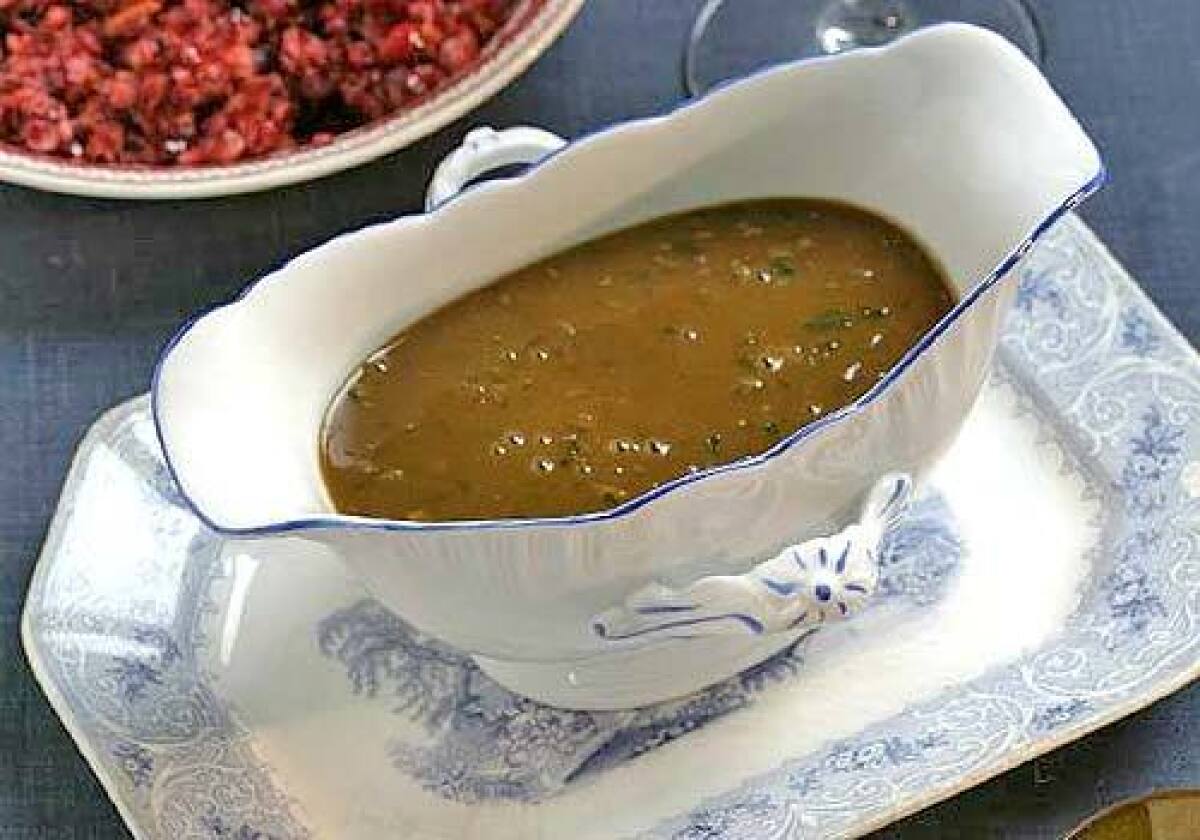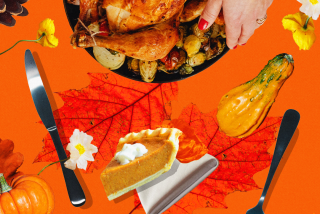And the rest is ...

THERE are few foods on the holiday table that carry the mystique of gravy. At its most basic level, it’s nothing more than a paste of flour and fat thinned with turkey stock, yet it somehow has the capacity to strike fear in otherwise brave-hearted cooks.
Granted, there are enough bad gravies out there to give a cook pause. But making a good gravy — one that tastes of turkey essence and not flour and that lightly naps the food rather than smothering it — is only a little more complicated than stirring together a white sauce.
The words sauce and gravy are often used interchangeably, but in this context, what we mean by gravy is liquid thickened by flour rather than by reduction.
If you want to make sauce for your turkey, pour all the fat out of the roasting pan, set the pan over high heat and when the browned bits that stick to the bottom start to sizzle, deglaze with white or red wine, scraping to free all the scraps. Reduce this to a syrup and add turkey stock. Reduce by about one-third and whisk in a couple of tablespoons of cold butter before serving.
Though a sauce should be made right in the roaster, gravy can be made either in the roasting pan or in a saucepan, which, because it is smaller, is easier for beginners to handle. The roaster, though, has the advantage of eliminating a step since all those great browned sticky bits are already in the pan.
The thickness of the gravy is dictated by the ratio of fat-and-flour paste to liquid. A customary white sauce (such as one you might use for making lasagna) has about two tablespoons each of fat and flour for every cup of liquid.
Obviously, that is way too thick for turkey. That much paste will thicken about 1 1/2 cups of stock to just about the right gravy consistency — just thick enough to coat the back of a wooden spoon. Keep extra stock handy, though. As the gravy simmers, it will gradually thicken some more and you might want to thin it.
The most critical phase of making gravy is right at the start, when you make the paste and add the first bit of liquid to it. This is what makes the difference between a gravy that is silky and one that is lumpy. After that, everything is easy.
Start by whisking the flour into the hot fat — you can stir it in with a wooden spoon, but a long whisk will incorporate it more smoothly. Cook the paste over medium heat until it turns a tannish brown — three to five minutes. You’ll want to heat it just long enough to begin to cook the paste, but not so long that it darkens and begins to scorch. Add a ladleful of liquid and whisk like crazy, working out any clumps. It will start to thicken almost immediately. Gradually add the remaining liquid, a ladleful at a time, whisking all the while.
Once all the liquid has been added and the gravy is smooth, add the chopped meat from the neck and giblets and any other ingredients, such as puréed roasted shallots or sautéed mushrooms.
Let the gravy simmer for at least 20 minutes to get rid of any raw flour taste. Sample a spoonful occasionally and you will see how the flavor develops.
While it’s simmering, carefully skim the surface with a big spoon to remove any “skin” that forms. That’s just dried-out protein from the flour, by the way, and as with everything else about gravy making, it’s absolutely nothing to be afraid of.
*
Giblet gravyTotal time: 45 minutes plus stock-simmering time
Servings: Makes about 3 cups
1 onion, quartered
1 cup chopped carrot
1 cup chopped celery
Assorted turkey pieces — neck, wingtips, tail, gizzard and heart (but not the liver)
1 bay leaf
1 bunch (about 14 sprigs) parsley
1 sprig fresh thyme
1/4 cup fat skimmed from roasting pan, with butter added if necessary to make 1/4 cup
1/4 cup flour
Salt to taste
1/4 teaspoon powdered sage (if serving sage dressing)
Freshly ground black pepper
1. In a large saucepan, combine the onion, carrot, celery, turkey pieces, 6 cups water, the bay leaf, parsley and thyme. Bring to a simmer, partially cover and cook for at least 2 hours.
2. After cooking, strain the stock into a measuring cup. You’ll need about 3 1/2 to 4 cups of stock. Peel the tough skin from the gizzard; chop the gizzard and heart finely. Set aside.
3. When the turkey comes out of the oven, remove it to a platter to rest. Place the roasting pan over a burner set to high. Remove any garlic, onions, herbs or aromatics with a slotted spoon and discard. Let the pan sizzle for a minute; add the stock, scraping the pan with a wooden spoon to free any browned bits.
4. Pour this mixture into a fat separator or back into the measuring cup and set aside for a couple of minutes to let the fat separate.
5. In a saucepan over medium heat, add one-fourth cup skimmed fat or whatever amount of fat you have plus enough melted butter to make about one-fourth cup. Whisk in the flour and let it cook for 1 to 2 minutes, whisking constantly.
6. Slowly add 1 cup of stock, whisking constantly, being careful to add as little of the top layer of fat as you can. The sauce will thicken almost immediately. Gradually add more stock, about 1 cup at a time, whisking until the gravy is just thick enough to coat the back of a spoon.
7. When all of the stock has been added, season to taste with salt, sage and a couple of grinds of black pepper. Simmer over low heat for 15 minutes to cook out the taste of the raw flour. Occasionally, use a large soup spoon to skim off the skin of protein that forms on the top.
8. About 5 minutes before serving, stir in the chopped giblets. Ladle into a warmed gravy boat.
Each tablespoon: 18 calories; 1 gram protein; 1 gram carbohydrates; 0 fiber; 1 gram fat; 0 saturated fat; 6 mg. cholesterol;
7 mg. sodium.
Variations
Roasted shallot gravy: Add 4 whole, unpeeled shallots to the roasting pan with the turkey for the last hour of cooking. When the turkey is finished, peel the shallots, chop finely and add to the gravy.Herb gravy: Mince 1 shallot along with 2 tablespoons chopped parsley and the leaves from 1 sprig of thyme. Whisk this into the thickened gravy and cook 5 minutes. Omit the sage.
Mushroom gravy: Clean and quarter 1 pound mushrooms. Sauté in a very hot pan with 2 tablespoons butter. When almost done, sprinkle in 1 minced shallot; add to the thickened gravy. Cook 5 minutes.
More to Read
Eat your way across L.A.
Get our weekly Tasting Notes newsletter for reviews, news and more.
You may occasionally receive promotional content from the Los Angeles Times.







